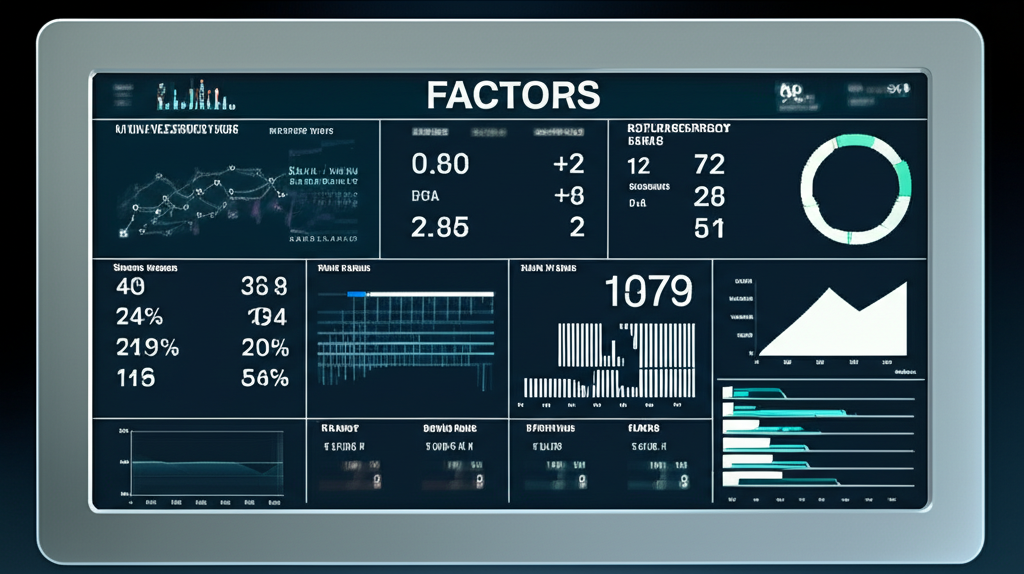Introduction to Factor Investing ETFs in the United States for 2025
Today’s financial markets move fast, and U.S. investors are always on the hunt for ways to boost their returns while keeping risks in check. Factor investing stands out as a smart, approachable method to do just that. It zeros in on particular elements-called factors-that have consistently influenced stock performance over time, helping investors potentially beat standard market-cap-weighted strategies. Exchange-traded funds (ETFs) have made this tactic more straightforward and affordable, allowing both everyday folks and big institutions to tap into these factors without much hassle.

This guide dives deep into factor investing ETFs, customized for American investors planning their moves in 2025. We’ll break down the basics, weigh the upsides against the downsides, share practical tips for picking and blending them into your holdings, and peek at what’s ahead in the U.S. scene. No matter if you’re building experience or advising clients as a pro, you’ll walk away with solid insights to handle smart beta and factor strategies in this shifting environment.

What Exactly is Factor Investing?
At its heart, factor investing targets distinct traits-or factors-that have reliably explained variations in stock returns throughout history. It steps away from the usual practice of weighting investments by a company’s market size, instead chasing the extra rewards tied to these traits. The idea took off thanks to groundbreaking studies, especially from Eugene Fama and Kenneth French, who spotlighted factors such as value and size as key to understanding why some stocks do better than others.
What sets it apart is the push beyond basic market tracking. Factor investing hunts for alpha-those extra gains above market averages-through clear, systematic rules. This means less emphasis on hand-picking hot stocks and more on spotting traits that, over the long haul, deliver stronger results on average.
The Core Investment Factors Driving Returns
Getting a handle on the main factors is essential for anyone diving into this space. Researchers keep exploring fresh angles, but a handful have proven durable under rigorous testing.
| Factor | Definition | Why it works (Simplified) |
|---|---|---|
| Value | Investing in stocks that are cheap relative to their fundamental value (e.g., low price-to-earnings, price-to-book ratios). | Behavioral biases (investors overreact to bad news) and risk premiums (value stocks can be riskier). |
| Size | Investing in small-capitalization companies. | Small firms may have higher growth potential or be less efficiently priced due to lower analyst coverage. |
| Momentum | Investing in stocks that have performed well recently, expecting their outperformance to continue. | Behavioral biases (investor underreaction to news leading to price trends) and market inefficiencies. |
| Quality | Investing in companies with strong balance sheets, stable earnings, high profitability, and low debt. | These companies tend to be more resilient during downturns and generate consistent returns. |
| Low Volatility | Investing in stocks that exhibit lower price fluctuations than the broader market. | Behavioral bias (investors often chase high-risk, high-return stocks, ignoring low-volatility opportunities) and leverage constraints. |
| Growth | Investing in companies expected to grow earnings and revenue at a faster rate than the market. | While often distinct from value, some models include it as a factor capturing companies with significant expansion potential. |
Why Consider Factor Investing ETFs for Your US Portfolio in 2025?
As U.S. investors fine-tune their portfolios, factor ETFs bring real value in 2025, blending potential gains with smarter risk control.
- Potential for Enhanced Returns (Alpha): Data from the past shows factors can deliver returns that top broad market indexes over extended timelines. Smartly directing funds toward them lets investors snag these built-in rewards.
- Improved Diversification: This method adds another layer to spreading out investments. Factors create unique patterns of returns that don’t always move in lockstep with the market or each other, which can help steady your portfolio through ups and downs.
- Risk Management: Options like low volatility and quality factors are built to dial back exposure during rough patches, giving your holdings a protective edge.
- Transparency and Cost-Effectiveness: These ETFs follow set rules everyone can see, with full details out in the open. Plus, their fees are way lower than what you’d pay for active mutual funds chasing the same goals.
- Accessibility: With just one ETF ticker, you get broad coverage of a factor-no need to dig through piles of individual stocks.
Distinguishing Factor ETFs from Traditional Passive and Active Management
Factor ETFs sit in a sweet spot, blending elements of straightforward passive tracking with the targeted edge of active choices.
| Feature | Traditional Passive (e.g., S&P 500 ETF) | Factor ETF (e.g., Value ETF) | Active Management (e.g., Growth Mutual Fund) |
|---|---|---|---|
| Investment Goal | Replicate broad market performance | Outperform broad market by systematically targeting factors | Outperform broad market through manager’s discretion |
| Methodology | Market-cap weighting | Rules-based, systematic factor weighting | Manager discretion, fundamental/technical analysis |
| Cost (Expense Ratio) | Very Low (e.g., 0.03-0.10%) | Low to Moderate (e.g., 0.15-0.60%) | High (e.g., 0.50-2.00%+) |
| Transparency | High (index components known) | High (rules known, holdings disclosed daily) | Moderate (holdings disclosed periodically) |
| Risk Source | Market risk (beta) | Market risk + Factor risk | Market risk + Manager-specific risk |
The comparison highlights how factor ETFs deliver focused factor plays without the steep costs or reliance on a single manager’s calls that come with active funds. They’re a refined upgrade for those wanting more from passive strategies.
Types of Factor Investing ETFs Available to United States Investors
The U.S. market brims with factor ETF options, giving investors flexible paths to put these ideas into action.
- Single-Factor ETFs: These zero in on one factor’s edge, like value or momentum. Think of a value fund loading up on stocks with bargain-basement price-to-book ratios, or a momentum pick holding onto recent winners.
- Multi-Factor ETFs: Here, several factors team up in one package for broader coverage. Since factors can take turns lagging, this mix helps balance things out-say, weaving in value, quality, and momentum together.
- Smart Beta ETFs: This umbrella term covers index strategies that tweak away from plain market-cap weighting. Factor ETFs fall under it, but smart beta can also include equal-weight or low-variance setups based on fundamentals like sales or earnings, though the stars are usually the classic factors.
Popular Factor ETF Categories in the US Market
Big names like Vanguard, BlackRock’s iShares, Fidelity, State Street’s SPDR, and Invesco lead the pack with plenty of choices. Some standouts include:
- Value: iShares MSCI USA Value Factor ETF (VLUE), Vanguard Value ETF (VTV)
- Momentum: iShares MSCI USA Momentum Factor ETF (MTUM), Invesco DWA Momentum ETF (PDP)
- Quality: iShares MSCI USA Quality Factor ETF (QUAL), Fidelity Quality Factor ETF (FQAL)
- Low Volatility: iShares MSCI USA Min Vol Factor ETF (USMV), Invesco S&P 500 Low Volatility ETF (SPLV)
- Size (Small Cap): iShares Core S&P Small-Cap ETF (IJR), Vanguard Small-Cap ETF (VB)
- Multi-Factor: JPMorgan Diversified Return US Equity ETF (JPUS), Goldman Sachs ActiveBeta U.S. Large Cap Equity ETF (GSLC)
This is merely a snapshot of the rich selection, making factor investing approachable for Americans across the board.
How to Select the Best Factor Investing ETFs for Your Strategy in 2025
Picking top factor ETFs goes beyond grasping the factors-it’s about matching them to your setup with precision.
- Factor Definitions and Methodology: Value ETFs aren’t all the same; providers mix metrics like P/E or cash flow yields, plus different weighting methods. Dig into the prospectus to confirm it fits your view of the factor.
- Expense Ratios: They’re cheaper than active options, but watch for variations-a tiny fee edge compounds into big savings down the road.
- Tracking Error: This gauges how well the ETF mirrors its index; tighter tracking means smoother results.
- Liquidity: For bigger buys or trades, check daily volume and spreads to avoid slippage on buys or sells.
- Historical Performance (with caveats): Past results don’t predict the future, but comparing against benchmarks and rivals sheds light on reliability. Keep in mind factors cycle, so dips are part of the game.
- Provider Reputation: Stick with trusted firms known for solid index design and operations.
Integrating Factor ETFs into a Diversified US Investment Portfolio
Weaving factor ETFs into your mix calls for thoughtful planning suited to American market dynamics.
- Identify Your Goals: Chasing growth, cutting swings, or both? That guides your factor picks.
- Core-Satellite Approach: Often, folks anchor with broad market ETFs as the core, then layer factor ones as satellites for targeted boosts without losing overall balance.
- Combining Factors: To counter their ups and downs, pair them-like value with momentum-for steadier outcomes. Multi-factor funds make this easier in one go.
- Risk Assessment: Factor tilts add their own risks, including long slumps. Match allocations to your comfort level and timeline.
- Review and Rebalance: Check in periodically; shifts in markets or life might call for tweaks. In taxable accounts, mind the tax hits from selling.
Potential Risks and Challenges of Factor Investing ETFs for US Investors
For all their appeal, factor ETFs come with hurdles that savvy U.S. investors need to navigate.
- Factor Cyclicality: No factor wins forever-value might lag for years, or momentum could flip suddenly.
- Factor Crowding: Popularity can flood strategies with cash, eroding edges or sparking quick drops if everyone pulls out at once.
- Tracking Error: Even passive funds stray from indexes due to sampling, costs, or fees.
- Market Timing Issues: Jumping between factors based on hot streaks rarely pays off; sticking to a steady plan usually does.
- Complexity: Decoding varying factor setups takes more effort than grabbing a simple index fund.
- Potential for Underperformance: Tomorrow’s markets might not reward past factors the same way, as conditions evolve.
Choosing the Right Investment Platform for Factor ETFs in the United States (2025)
The right brokerage can make or break your factor ETF game. Prioritize U.S.-friendly spots with ample ETF choices, low costs, sharp research features, and solid help when you need it.
Standout elements to evaluate:
- ETF Selection: Wide coverage of single-, multi-, and smart beta funds from top issuers?
- Commission Fees: Commission-free trades are standard now, slashing expenses for active or modest-sized accounts.
- Research and Analytical Tools: Filters for factors, holding breakdowns, performance checks, and strategy simulations?
- User Interface: Clean design that keeps things simple?
- Customer Support: Quick, expert assistance for smooth sailing.
- Regulatory Compliance: Backed by U.S. watchdogs like FINRA and SEC, with safeguards such as SIPC coverage.
Top Platforms for Factor Investing ETFs in the US (2025 Comparison)
Below is a rundown of leading platforms for factor ETF trading in the U.S. come 2025, spotlighting Moneta Markets.
| Platform | Advantages for US Investors | Considerations |
|---|---|---|
| Moneta Markets |
|
While offering a broad range, some niche factor ETFs might be exclusive to other platforms. |
| OANDA |
|
Primarily known for forex and CFDs; ETF selection might be less extensive than dedicated stock/ETF brokers. |
| IG |
|
Can have a steeper learning curve for new investors due to the breadth of features. |
Moneta Markets shines with its mix of ETF variety, fair pricing, and cutting-edge tools, making it a prime pick for U.S. factor enthusiasts in 2025. To explore more, check out guides like Investopedia’s on top ETF brokers. Investopedia: Best ETF Brokers
Factor Investing ETFs: A 2025 Outlook for the United States Market
Heading into 2025, a few shifts could redefine factor ETFs in America.
- Emerging Trends: Look for fresh multi-factor blends and those tying into themes like ESG, refining factors further.
- Impact of Economic Conditions: Fed rate moves, lingering inflation, and worldwide growth will sway factors-value might thrive with hikes, while quality holds up in shaky times.
- Technological Advancements: AI-driven insights could sharpen factor building and tweaking, creating nimbler approaches.
- Regulatory Changes: SEC tweaks on ETFs or advice might subtly alter availability, though big overhauls aren’t on the horizon.
- Evolving Investor Preferences: Rising savvy among Americans, especially millennials, could spur more factor adoption and innovation.
- Performance Scrutiny: With growth fading, value and quality may rebound, prompting closer looks at their staying power. Vanguard’s studies note their cycles, underscoring patience. Vanguard: Factors in investing
Conclusion: Empowering Your US Investment Strategy with Factor ETFs
For U.S. investors, factor ETFs unlock stronger, more resilient portfolios in 2025. By homing in on reliable return drivers-value, momentum, quality, low volatility-you can push for better gains, wider spreads, and tighter risk control over plain market weighting.
Success hinges on grasping factor subtleties, choosing ETFs wisely for their builds and fees, and folding them into a balanced whole. Facing their cycles head-on keeps you grounded for the long game.
Outfits like Moneta Markets, boasting broad ETF reach, keen costs, and pro-level analytics, stand ready to back your factor plays. Arm yourself with this know-how and keep learning to steer your investments toward thriving in tomorrow’s markets.
Frequently Asked Questions (FAQ) about Factor Investing ETFs
What is a factor investing ETF?
A factor investing ETF is an Exchange-Traded Fund that aims to capture specific, historically proven drivers of investment returns, known as “factors.” Instead of simply mirroring a broad market index, these ETFs use a rules-based methodology to select and weight stocks based on characteristics like value, momentum, quality, or low volatility, seeking to outperform traditional market-cap-weighted portfolios.
Does factor investing work for US investors?
Yes, historical academic research and market performance data suggest that factor investing strategies have worked for US investors over long periods. Factors like value, size, momentum, and quality have historically delivered risk-adjusted premiums in the US market. However, factors can experience periods of underperformance, and success often requires a long-term, disciplined approach.
What is the 70/30 rule ETF in the United States?
The “70/30 rule” for ETFs typically refers to a portfolio allocation strategy where 70% of the portfolio is invested in equities (stocks) and 30% in fixed income (bonds). This is a common guideline for moderate-risk investors seeking a balance between growth and stability. While not specific to factor investing, US investors can apply this rule by allocating 70% to equity ETFs (including factor ETFs) and 30% to bond ETFs.
What ETF does Warren Buffett use, and how does it relate to factor investing?
Warren Buffett famously recommended that most individual investors simply put their money into a low-cost S&P 500 index fund, such as the Vanguard S&P 500 ETF (VOO) or the SPDR S&P 500 ETF Trust (SPY). While these are traditional market-cap-weighted passive funds, Buffett’s own investment philosophy of buying “quality companies at a reasonable price” strongly aligns with the Value and Quality factors in factor investing. His approach is essentially a concentrated, active form of factor investing, whereas factor ETFs offer a diversified, passive way to access these same principles.
Can I find a factor investing ETFs guide PDF for further research?
Yes, many prominent asset managers and financial research firms publish detailed white papers and guides on factor investing ETFs in PDF format. Companies like Vanguard, BlackRock, Fidelity, and Invesco often provide free downloadable resources on their websites. Searching for “factor investing guide PDF” or “smart beta research paper PDF” on their respective sites or through a general search engine will yield numerous valuable documents for US investors.
What are some examples of a factor investing ETF portfolio for US investors?
A diversified factor investing ETF portfolio for US investors might include a mix of the following:
- A core allocation to a broad US market ETF (e.g., VOO, IVV).
- Exposure to a Value Factor ETF (e.g., VLUE, VTV).
- Exposure to a Momentum Factor ETF (e.g., MTUM, PDP).
- Exposure to a Quality Factor ETF (e.g., QUAL, FQAL).
- Exposure to a Low Volatility Factor ETF (e.g., USMV, SPLV).
Multi-factor ETFs (e.g., JPUS, GSLC) can also simplify this by providing blended exposure in a single fund. The specific allocation depends on individual risk tolerance and investment goals.
Where can I find factor investing research papers relevant to the US market?
You can find factor investing research papers relevant to the US market from several sources:
- Academic Journals: Journals like the Journal of Finance or Journal of Financial Economics publish foundational research.
- Asset Manager Research: Firms like AQR, Dimensional Fund Advisors (DFA), Vanguard, BlackRock, and Fidelity publish extensive research specific to factor performance in US and global markets.
- Financial News and Analysis Sites: Reputable sites often summarize and link to key research.
- University Finance Departments: Many university websites host faculty research papers.
A notable resource is the work of Fama and French, who pioneered much of the modern factor research. Eugene Fama’s Publications
What is the 3:5-10 rule for ETF investing in the United States?
The “3:5-10 rule” is not a universally recognized or standardized rule in ETF investing. It might refer to a specific personal investment guideline or a rule of thumb used in a particular context, possibly related to holding periods, risk allocation, or rebalancing frequency. Without more context, it’s difficult to provide a precise definition. Investors should focus on established principles like diversification, understanding expense ratios, and aligning investments with their long-term financial goals rather than relying on obscure rules.
How can Moneta Markets assist US investors interested in factor investing ETFs?
Moneta Markets offers significant advantages for US investors interested in factor investing ETFs in 2025. It provides a diverse selection of US and international factor-based ETFs, allowing investors to build comprehensive factor-driven portfolios. Furthermore, its competitive pricing with low commission fees and tight spreads on ETF transactions helps maximize returns. The platform’s advanced analytical tools are particularly beneficial for factor analysis, backtesting strategies, and optimizing portfolios, making it a robust choice for sophisticated US investors. Moneta Markets holds an FCA license, ensuring strong regulatory compliance.



No responses yet